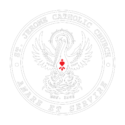Saint Jerome: An Example For Our Parish
Feast Day: September 30
Patronage: Archaeologists, Biblical Scholars, Librarians, Students, Translators
Saint Jerome, the fiery scholar of the early Church, stands as an enduring model of dedication to faith, intellect, and transformation. His life and works offer a profound legacy to any community bearing his name, inspiring all to pursue truth, deepen their knowledge of God, and courageously defend the faith.
Early Life and Conversion
Born Eusebius Sophronius Hieronymus in Stridon, a village on the borders of Dalmatia around 342 AD, Saint Jerome’s beginnings were marked by ambition and a thirst for learning. Educated under the renowned grammarian Aelius Donatus, he mastered Latin and Greek, laying the foundation for his eventual mastery of Hebrew and Chaldaic. Yet, in his youth, Saint Jerome struggled with the temptations of the world, indulging in pleasures that conflicted with his conscience.
Haunted by guilt, he sought solace in the Roman catacombs, where the inscriptions on the tombs stirred his imagination and fear of divine judgment. These meditative visits led Saint Jerome to conversion and baptism under Pope Liberius around 366 AD. His life pivoted from secular ambitions to the service of God, setting the stage for his future as a pivotal figure in the Church.
Scholarship and Asceticism
Saint Jerome’s passion for Scripture and theology took him on a journey across Europe and the East. In Treves, Aquileia, and Antioch, he cultivated his knowledge of the Bible and the Church Fathers, eventually retreating to the Chalcis desert for four years of ascetic life. This solitude sharpened his focus, allowing him to engage in prayer, penance, and study.
During this time, Saint Jerome experienced divine visions that fortified his resolve. His scholarly works began to flow, starting with treatises and commentaries that would later serve as cornerstones of Christian theology. Despite his sharp intellect, Saint Jerome’s fiery temper and acerbic wit often caused friction with contemporaries, but these traits also fueled his unwavering defense of orthodoxy.
Champion of Scripture
The pinnacle of Saint Jerome’s life was his monumental work on the Latin Vulgate. Commissioned by Pope Damasus in 382 AD, Saint Jerome devoted decades to translating the Bible from Hebrew, Greek, and Aramaic into Latin, the common tongue of the Western Church. This translation became the definitive Scriptural text for over a millennium and remains a testament to Saint Jerome’s brilliance and dedication.
Saint Jerome’s commitment to biblical scholarship and teaching inspired generations of Christians to engage deeply with the Word of God. His writings, often penned amidst conflict and criticism, defended the virginity of Mary, the doctrine of Christ’s divinity, and the unity of the Church. His debates, though contentious, were marked by a passion for truth and a zeal for leading others closer to Christ.
Legacy for a Parish
For our parish, dedicated to Saint Jerome, his life offers invaluable lessons:
Dedication to Learning: Saint Jerome’s relentless pursuit of knowledge, even in the face of challenges, reminds us of the importance of catechesis and biblical study. Programs in Scripture study, theological education, and library initiatives are natural extensions of his legacy.
Devotion to Truth: Saint Jerome’s courage in confronting heresies and proclaiming the Gospel underscores the need for steadfast faith in the face of societal challenges. A parish named after him should embrace apologetics and evangelization as key missions.
Humility and Transformation: Saint Jerome’s struggles with sin and his eventual transformation into a devoted servant of God inspire us to seek God’s grace through the Sacraments and personal conversion.
Compassionate Outreach: Though Saint Jerome was sharp-tongued, his mentorship of figures like Saint Paula and his pastoral care for others illustrate the importance of guiding souls with love and patience.
Patron of Lifelong Learning and Service
As a patron saint of scholars, librarians, and translators, Saint Jerome is a fitting model for a parish devoted to fostering knowledge and spirituality. Whether through faith formation classes, the establishment of a parish library, or the translation of faith into action, Saint Jerome’s influence can shape a vibrant, informed, and mission-driven community.
Prayer to Saint Jerome
O Glorious Saint Jerome,
You who sought the Word of God with such fervor and translated its mysteries for the benefit of all,
Inspire us, your devoted parishioners, to cherish the Scriptures,
To strive for wisdom, and to live by the truth you so fiercely defended.
Guide us in our studies, transform our hearts in service to Christ,
And teach us to always seek the light of God’s eternal wisdom.
Amen.
Through the intercession of Saint Jerome, may this parish continue to grow in faith, learning, and devotion, echoing his cry: “Ignorance of Scripture is ignorance of Christ.”
